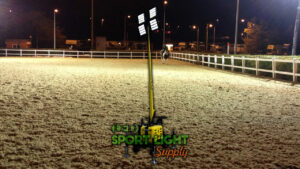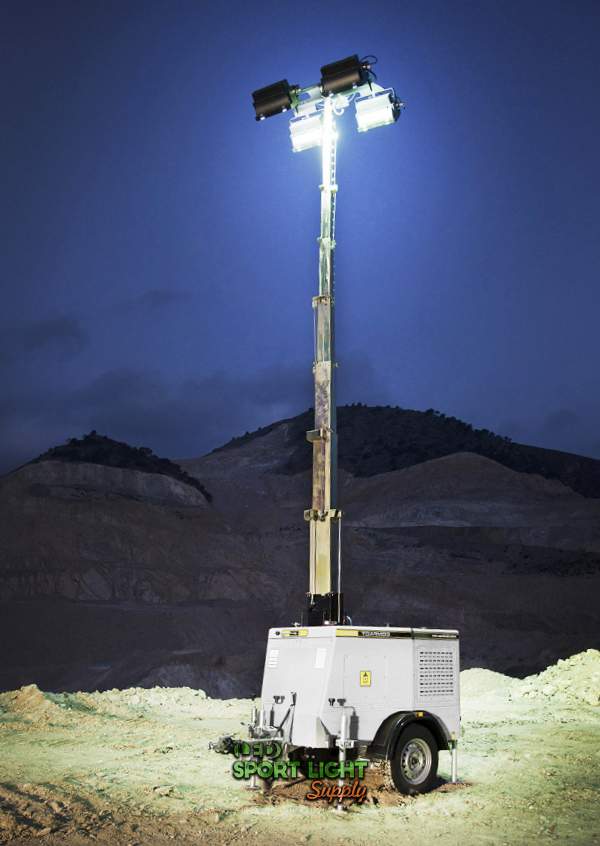
Traditional lighting setups often fall short when it comes to energy efficiency, flexibility, and the quality of illumination needed in equestrian arenas. In this context, LED lighting has emerged as a superior alternative, offering a host of advantages that make it an ideal choice for such events. From ensuring optimal visibility to enhancing the performance of riders and horses, LEDs bring a new level of efficiency and adaptability to equestrian lighting solutions.
Table of Contents
Toggle Equestrian events often take place in temporary arenas, where the availability of reliable power sources can be limited. Here, the energy efficiency of LED lighting proves to be particularly advantageous. Unlike older lighting technologies, which can be power-hungry, LEDs consume significantly less electricity, making them well-suited for setups where energy resources are constrained. This efficiency translates into reduced fuel consumption for generators, which are often used to power portable lights in outdoor settings.
Equestrian events often take place in temporary arenas, where the availability of reliable power sources can be limited. Here, the energy efficiency of LED lighting proves to be particularly advantageous. Unlike older lighting technologies, which can be power-hungry, LEDs consume significantly less electricity, making them well-suited for setups where energy resources are constrained. This efficiency translates into reduced fuel consumption for generators, which are often used to power portable lights in outdoor settings.
LEDs convert a much larger proportion of energy into light rather than heat, which not only reduces power consumption but also minimizes heat buildup in enclosed spaces. This is especially beneficial for indoor or partially covered arenas where excess heat can affect the comfort of both horses and riders. By optimizing energy use, event organizers can maintain adequate lighting levels without worrying about overloading power sources or increasing operational costs.
In addition to their energy-saving benefits, LEDs have a notably long lifespan compared to traditional lighting options. This durability reduces the frequency of replacements, which can be a costly and time-consuming task in portable setups. Equestrian events often span multiple days, and the ability to rely on lighting fixtures that do not require frequent maintenance is a clear advantage. With LEDs, event planners can focus on the seamless execution of the event without being interrupted by the need to change bulbs or address malfunctions.
One of the standout features of LED lighting is its capacity to produce bright, even illumination across large spaces. In equestrian arenas, uneven lighting or harsh glare can create shadows that obscure the view of the horse and rider, potentially affecting their performance. Riders depend on clear visibility to navigate obstacles and maintain control, while judges require consistent lighting to accurately assess performances. LEDs excel in this regard by delivering uniform light distribution, eliminating dark spots and minimizing glare.
The precise nature of LED illumination enhances the overall experience for spectators as well. Whether events are held during the day or in the evening, LEDs ensure that attendees have a clear view of the action without the distractions caused by inconsistent lighting. This is particularly beneficial for events that are filmed or live-streamed, as high-quality lighting improves video clarity and ensures that viewers at home can fully appreciate the performances.
Safety is a primary concern in equestrian sports, where both horses and riders are susceptible to accidents. Inadequate lighting can increase the risk of missteps, especially in fast-paced or high-stakes events. By reducing shadows and providing consistent illumination, LED lights create a stable environment that helps to reduce anxiety in horses, allowing them to perform with greater confidence. This stability is crucial for maintaining the focus of the rider, who can better anticipate and respond to the horse’s movements when lighting conditions are predictable.
Equestrian events are often held in varied settings, ranging from open outdoor fields to temporary indoor arenas. The versatility of LED lighting makes it an ideal choice for these diverse environments. Modern LED fixtures are designed to be lightweight and easy to install, making them perfect for portable setups where equipment needs to be moved and reconfigured quickly. Whether mounted on poles or attached to temporary structures, LEDs provide a high degree of flexibility that traditional lighting systems cannot match.
LEDs also perform well in different weather conditions, which is crucial for outdoor events where lighting fixtures may be exposed to elements like rain, wind, and dust. Their durability ensures that they can withstand harsh conditions without a significant decrease in performance. This resilience makes LEDs a dependable solution for lighting setups that may need to be adjusted or relocated at short notice.
Another advantage of LED lighting systems is their adaptability to specific lighting needs. Many modern LED setups come equipped with adjustable features such as dimming capabilities and color temperature controls. This allows event organizers to customize lighting levels based on the time of day, weather conditions, or the nature of the competition. For instance, brighter, daylight-like illumination can be used for daytime events, while a warmer tone might be preferred for evening shows to create a more relaxed ambiance.
Adjustable LEDs also help to conserve energy by providing just the right amount of light needed for each situation. This flexibility is particularly useful for events that run late into the evening, where gradually dimming the lights can help transition the atmosphere without sacrificing visibility.
The quality of light produced by LED fixtures surpasses that of traditional lighting technologies in terms of color rendering. In equestrian competitions, where riders and judges rely on visual cues, having accurate color representation is crucial. LED lights provide a higher color rendering index (CRI), which means that colors appear more vivid and true to life under LED illumination. This is particularly important in dressage events, where fine details of the horse’s movements and attire are closely scrutinized.
In addition to improving color accuracy, the uniform light distribution offered by LEDs reduces harsh contrasts and shadows that can make it difficult for judges to assess performances. Riders can also benefit from better visibility of the arena’s features, allowing for smoother maneuvers and increased precision during competitions.
The steady, flicker-free light output of LEDs reduces visual fatigue, making it easier for horses and riders to focus over extended periods. Traditional lights, which can produce flicker or harsh glare, may cause discomfort and distract both horse and rider. This can be particularly challenging in events that require intense concentration, such as show jumping or timed obstacle courses. The consistency of LED lighting helps to create a more comfortable environment, which can enhance performance by allowing participants to concentrate fully on the task at hand.
Switching to LED lighting for equestrian events is not just beneficial for event organizers but also contributes to broader environmental goals. LEDs are much more energy-efficient than conventional lighting options, reducing overall electricity consumption. This reduction translates to a lower carbon footprint, which is increasingly important as event organizers strive to make their operations more sustainable. By minimizing the environmental impact of lighting setups, equestrian events can align with sustainability initiatives that prioritize energy conservation.
The economic benefits of using LED lighting extend beyond energy savings. Although the initial cost of investing in LED fixtures may be higher than that of traditional lights, the long-term savings are significant. LEDs last much longer than halogen or fluorescent bulbs, which means fewer replacements are needed over time. This reduces both material costs and the labor associated with maintenance. Furthermore, the reduced energy usage leads to lower electricity bills, which can be a substantial saving for events that require extensive lighting over several days.
In addition to their longevity, LED fixtures are made from materials that are more recyclable than those used in traditional lighting options. The durability of LEDs means less waste generated from discarded bulbs, aligning with sustainable practices that focus on reducing landfill waste. By opting for LED technology, event organizers can contribute to a circular economy model, where the emphasis is on minimizing waste and promoting the reuse of resources.
The adoption of LED lighting in equestrian events represents a shift toward more efficient, flexible, and sustainable lighting solutions. With their energy efficiency, adaptability, and superior illumination quality, LEDs are well-suited to the unique needs of equestrian arenas. By investing in LED technology, event organizers can not only enhance the performance and safety of participants but also reduce costs and contribute to environmental sustainability. As the demand for portable and efficient lighting continues to grow, LEDs will likely play an increasingly central role in shaping the future of equestrian event lighting.
Drop us a line to receive a free lighting design